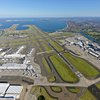When travelers discuss an air journey to Australia they immediately think of Sydney Airport - The Gateway to Australia. The airport is also known as Mascot Airport due to its location in Mascot, New South Wales and Kingsford Smith Airport after famous Australian aviator Charles Kingsford Smith. It is the primary international airport for the continent of Australia handling over 43 million passengers and approximately 350,000 aircraft movements annually.

History
The site of the airport is rich with Australian history. It is located on the northern shore of Botany Bay where early colonialist and adventurers, including Captain James Cook, came ashore in the 18th century. We have to jump forward to the 20th century to talk about the first flight operations. In 1919, an aircraft manufacturing company set up operations at the site and Mascot Aerodrome was established. The Australian government acquired the facility in the early 1920’s and declared it as a national airport. Through the years that followed land was acquired, runways were created, terminals were built, access roads were made, and rail access was added.
Airlines
Flights on airlines from all over the world bring over 43 million passengers to Sydney Airport. Sydney is one of the prize destinations for major global airlines. Top international cities with traffic to/from Sydney in rank of passenger numbers include Auckland, Singapore, Hong Kong, and Los Angeles. Melbourne, Brisbane, Gold Coast, and Adelaide rank at the top for domestic passengers. Qantas (Qantas is actually an acronym for Queensland and Northern Territory Aerial Services) claims Sydney Airport as its main base of operations. Jetstar, Regional Express, tigerair Australia, and Virgin Australia also have sizeable operations. Global airlines include Air Canada, Air China, Air New Zealand, All Nippon, American, Asiana, British, Cathay Pacific, China Airlines, Delta, Emirates, Etihad, JAL, Korean, LATAM, Qatar, Singapore, and United.
Additionally, several airlines devoted strictly to the transport of cargo use Sydney Airport. Nearly 500,000 tons of freight and international air post pass through the dedicated cargo facilities annually. Major cargo operators at the airport include Atlas Air, DHL Express, FEDEX, Polar Air Cargo, and UPS.

Terminals
There are three terminals at Sydney Airport. Terminal 1 (T1) has 25 gates that handle international flights. Terminal 2 (T2) has 16 dedicated gates and several bus accessible gates that handle domestic flights. Terminal 3 (T3) has 22 gates and is dedicated solely to Qantas and QantasLink domestic flights. Amenities in each include a variety of dining options (many located in food courts), duty-free boutiques, lounges, shops, and various services (baggage storage, bank ATM’s, information desks, and medical help). The airport authority has consistently made updates to keep each terminal modern and efficient. One important fact about the airport layout is that the international terminal T1, is across a runway from domestic terminals T2 and T3. Bus service is provided to passengers if they are transferring to/from international flights to/from domestic flights. Qantas and Virgin Australia have their own separate operations for handling transfers between the terminals.
Changes for today and the future.
Modernization is a key element to the success of operations at an airport. Sydney Airport remains committed to this belief and continues to update. Recently it implemented automated check-in and baggage drop zones in T1 allowing for a more efficient check-in processing experience. A complete revision of the food and beverage offerings to satisfy current desires was also implemented. Next up will be adding technology handling facial recognition. Sydney Airport continuously innovates to make the passenger experience and the welcome to or farewell from Australia the best.










